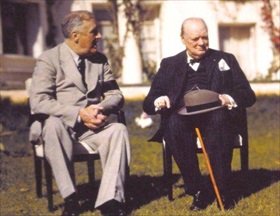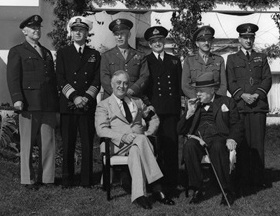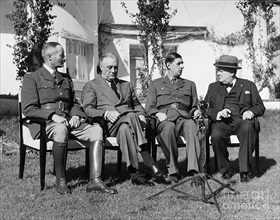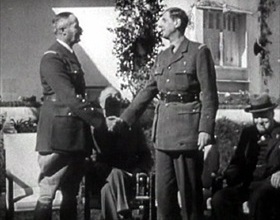ROOSEVELT, CHURCHILL ENDORSE NEW WAR AIMS
Casablanca, French Morocco • January 14, 1943
On this date in 1943 U.S. President Franklin D. Roosevelt, British Prime Minister Winston Churchill, and their respective Chiefs of Staff opened a ten-day strategy conference in Casablanca, a seaside resort halfway down the Moroccan coast in Northwest Africa. (Casablanca was a significant venue, chosen to underscore the liberation of French North Africa in the wake of the initial success of Operation Torch.) Remarkable for his absence was the third Allied statesman, Joseph Stalin, whose armed forces struggled to evict “German occupationists” (as the Soviet dictator called them) along a thousand-mile/1,600 km-plus front deep inside his country and who were, at that very moment, fixated on eradicating the German Sixth Army inside Stalingrad (today’s Volgograd). In attendance also were rival generals Charles de Gaulle and Henri Giraud representing Free French forces.
The decisions reached and the plans made at the historic Casablanca Conference significantly affected future events in the European Theater. For example, the “Big Two” agreed to open a second front, which Stalin had been insisting on for months. Opening a new front in the West would compel the Germans to split their armed forces (concentrated largely in the East) and defend themselves in 2 places at once. Roosevelt, Churchill, and their military staffs settled on a landing in Sicily, Italy (Operation Husky), in mid‑1943 after ruling out a cross-Channel landing in France—Roosevelt’s initial position—because the hundreds of thousands of untested Americans who were required to carry off a successful cross-Channel invasion were only now arriving in England, and they needed plenty of training and equipment.
Conference participants also agreed to intensify and “rationalize” day and night bombing of Germany. Priority targets would be submarine construction yards, aircraft factories, transportation networks, oil plants, and other war-related industrial facilities. Acting on the “Casablanca Directive” were Air Marshal Sir Arthur (“Bomber”) Harris, chief of British Bomber Command, and Lt. Gen. Ira C. Eaker, chief of the U.S. Eighth Air Force based in Britain. Within days the Royal Air Force visited Berlin, its first raid on the Nazi capital since November 7, 1941, while the Eighth Air Force carried out its first raid over Germany, bombing a naval base in the North German city of Wilhelmshaven and a submarine base at Emden.
The most historically important and provocative position the Big Two took was to insist on the unconditional surrender of the Axis powers and the prosecution of their leaders. The position was made public to the news media at the end of the conference. Roosevelt had earlier broached the idea of unconditional surrender of the Axis powers to Churchill, and the British prime minister had warmed up to it when his war cabinet in London made no objections to it. The American president had borrowed the term “unconditional surrender” from U.S. Civil War hero Gen. Ulysses S. Grant, explaining to a radio audience on February 12, 1943: “In our uncompromising policy we mean no harm to the common people of the Axis nations. But we do mean to impose punishment and retribution upon their guilty, barbaric leaders.”
Casablanca 1943: Inter-Allied Summit Meeting Between Roosevelt, Churchill, and Free French Leaders
 |  |
Left: The Casablanca Conference, codenamed Symbol (January 14–24, 1943), was a secret meeting of U.S. President Franklin D. Roosevelt, British Prime Minister Winston Churchill, and their military operations and planning staff (known as the Combined Chiefs of Staff) to advise on Allied strategy for the next phase of the war in Europe. The first of the great Allied mid‑war conferences and the first time a sitting president left the U.S. during wartime, the conference agenda addressed the specifics of tactical procedure, allocation of resources, and the broader issues of diplomatic policy. The debate and negotiations produced what was known as the “Casablanca Declaration,” which included the demand for unconditional surrender of the Axis powers along with their leaders.![]()
Right: Roosevelt and Churchill seated in front of a full complement of Allied admirals, generals, and field marshals in the garden of the Anfa Hotel in a suburb of Casablanca, January 1943. Standing, front row, left to right: Commanding General of the U.S. Army Air Forces Henry “Hap” Arnold; Commander in Chief, United States Fleet and Chief of Naval Operations Admiral Ernest J. King; U.S. Army Chief of Staff Gen. George Marshall; British Admiral of the Fleet Sir Dudley Pound; British Air Chief Marshal Charles Portal; and Gen. (later Field Marshal) Alan Brooke. Gen. Arnold continued the Casablanca discussions in Chungking, China, with Generalissimo Chiang Kai-shek, which resulted in definite plans for offensive operations in the Pacific Theater.
 |  |
Above: Rival leaders of the Free French forces Generals Henri Giraud (left) and Charles de Gaulle (sandwiched between Roosevelt and Churchill) at the Casablanca Conference. Roosevelt and Churchill called for the official recognition of a joint leadership of the Free French forces, notwithstanding the notable tension between 5‑star Gen. Giraud, a vain man who had previously declared his fealty to Marshal Philippe Pétain’s World War II pro-German Vichy government but had switched loyalty to the Americans who supported his appointment as High Commissioner of France in North Africa and commander-in-chief of the [French] Army of Africa after the Christmas Eve 1942 assassination of French Adm. François Darlan, and equally vain 1‑star Gen. de Gaulle, who enjoyed the support of resistance movements in metropolitan France. Roosevelt and Churchill used their considerable powers of persuasion to have the 2 generals “make nice” to each other, even staging this photo-op on January 17, 1943, to demonstrate public cordiality between them. It lasted through just 2 handshakes and several camera clicks. Roosevelt mocked the 2 French generals’ relationship as a “shotgun marriage.”

 History buffs, there is good news! The Daily Chronicles of World War II is now available as an ebook for $4.99 on Amazon.com. Containing a year’s worth of dated entries from this website, the ebook brings the story of this tumultuous era to life in a compelling, authoritative, and succinct manner. Featuring inventive navigation aids, the ebook enables readers to instantly move forward or backward by month and date to different dated entries. Simple and elegant! Click
History buffs, there is good news! The Daily Chronicles of World War II is now available as an ebook for $4.99 on Amazon.com. Containing a year’s worth of dated entries from this website, the ebook brings the story of this tumultuous era to life in a compelling, authoritative, and succinct manner. Featuring inventive navigation aids, the ebook enables readers to instantly move forward or backward by month and date to different dated entries. Simple and elegant! Click 











